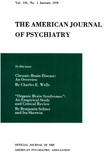Abstract
The time has not yet arrived to state in terms of psychodynamics what actually goes on during group psychotherapy meetings. What can be done right now is the collection of observations, the reporting of this material and the exchange of opinion. It is fashionable now to talk about thepatient as a whole. My army experience has taught me to talk also about the treatment as a whole. G.P.T. was only a part of such treatment as a whole. Another part of the whole was the previous hospitalization, the chain of evacuation, the admission to the last hospital, the observation on the closed ward, the work up, the board meeting, the life on the ward, the Red Cross activities, the visiting hours, the sick leave, finally the transfer to the open ward and the reconditioning barracks. Group psychotherapy is only a part of this hospital life. During all of this time the men had to adjust simultaneously to different and difficult situations, among them the fact that they were back in the States, that they were considered mental cases, that the war was over as far as they as individuals were concerned, that they were not only supposed to go home but also supposed to get well. It is a difficult and complicated adjustment to make and G.P.T. is a part of this development.
Group psychotherapy offers emotional support to the members of the group by giving them group status before they have reestablished their status as healthy individuals. This group status gives strength to the individual and is felt as reassurance. It is expressed in the feeling of belonging towards the other group members and in feelings of confidence towards the central figure of the group, the physician.
The group develops with greater ease a positive transference to the central figure than the individual soldier with his ingrained distrust for the military physician. This transference can be used to overcome a part of the resistance towards recovery. This is accomplished by the creation of a therapeutic group-optimism, an esprit de corps with which the traumatic experience of having been mentally sick and branded as N.P. case may be eliminated. In this respect, G.P.T. accomplishes a reintegration of previously established pattern; more than that it constitutes a new orientation of the personality structure.
In the group meetings a chance is given for catharsis of anxiety, aggression and guilt without danger to the individual but with intensity enough to be of therapeutic benefit. In the discussions which follow almost the rule of free associations, defenses can be tested and modified, interpretations can be given and accepted, insight may be gained and unconscious material may come into consciousness. Interpretations may be given as far as both resistance and unconscious contents are concerned. Inherent in the character of the group meeting is the fact that the procedures remain largely on the level of reality testing.
In group psychotherapy an emotional experience of integrated human group relation is felt; at first, so to speak, the group matures as compared with other groups in the hospital. Later the individual improves. The final integration of the army experience is an ego-strengthening development. This process of socialization is actually experienced in the group meetings by the individual. The traumatic situation of sudden individualization in the beginning of the neurosis is relived in the relative safety of a new and kinder group than the combat team, and brought to a happy ending, which includes the dismissal of the group and the soldier's final return home.

